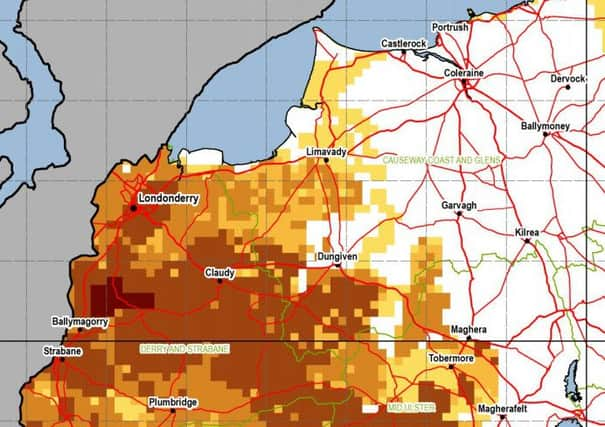Killer gas is seeping into lots of our houses


Meanwhile, between 10 and 30 per cent of homes in much of Londonderry, including most of the Waterside and the rural village of Claudy are also deemed to be high risk.
Radiation experts at Public Health England and the British Geological Survey, using geological information from the Geological Survey of Northern Ireland and radon measurements, including many made with support from the Northern Ireland Environment Agency, have published a new map for Northern Ireland (see picture) which has increased the total number of homes at-risk.
Advertisement
Hide AdAdvertisement
Hide AdHouseholds across Northern Ireland are being encouraged to test for the potentially lethal gas, which is naturally occurring and seeps into homes from the ground.
Long term exposure can lead to cancer and it is estimated that every year there are about 1,000 radon linked lung cancer deaths in the UK. However there are practical measures that can be taken to substantially cut the level of radon exposure.
Neil McColl, head of radon at Public Health England’s Centre for Radiation, Chemical and Environmental Hazards, said: “We estimate some 155,000 homes, about 1 in 5 in Northern Ireland, are now in ‘Affected Areas’: these are places where some householders are exposed to radon at a level where we recommend protective action.
“This is an increase on the last estimate we made of the total number of Northern Ireland homes at risk. Of course few will have radon at a level that requires attention, but there will be some.
Advertisement
Hide AdAdvertisement
Hide Ad“There are definite health risks from radon, particularly if you’re a smoker or an ex-smoker, so we want people to take this seriously and think, especially if they’re in an affected area, about what steps they should take.”
The last radon map of Northern Ireland, published in 2009, identified about 90,000 homes being at risk from higher levels of radon. The new map combines thousands of radon measurements with detailed geological information to produce a more accurate map.
Dr Kate Royse, Science Director for Environmental Modelling at the British Geological Survey said: “Our unique collaboration brings together an understanding of radon in the rocks with household radon measurements enabling us to produce a much more accurate radon map for Northern Ireland. “This will help to increase the awareness of radon gas emissions in Northern Ireland and enable those homes affected by high radon values to take simple steps to reduce their exposure.”
Dr Mark Cooper, Chief Geologist for Northern Ireland at the Geological Survey of Northern Ireland said: “The arrangement of geology across Northern Ireland is such that rock types that are more prone to radon production, such as granite, limestone and mudstone, occur mainly in the southeast and west.
Advertisement
Hide AdAdvertisement
Hide Ad“The areas more widely affected are: Newry, Mourne and Down in the south east, Londonderry and Strabane in the north west and Fermanagh and Omagh in the south west.”
Dr Gerry Waldron, Consultant in Health Protection at the Public Health Agency in Northern Ireland, said: “You won’t know if your home has a high level of radon unless you test, so we’re urging people to have a look at our new map, find if their home is an affected area and if so get a test. Testing is easy, it is not intrusive and there are plenty of websites online where you can order a radon test.
“It’s not only homes where radon is an issue. Although we all get our greatest exposure at home, because it’s where we spend most of our time, employers have responsibilities under health and safety laws to protect their staff. So it’s important they look at the new maps too so they can see if their workplace is at risk.”
For more information about the practical measures that can reduce radon exposure and to view the maps visit www.ukradon.org.